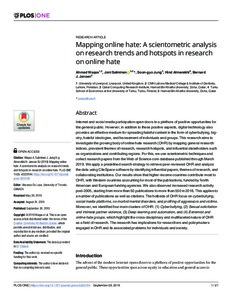Mapping online hate: A scientometric analysis on research trends and hotspots in research on online hate
Ahmed Waqas; Joni Salminen; Soon-gyo Jung; Hind Almerekhi; Bernard J. Jansen
https://urn.fi/URN:NBN:fi-fe2021042825618
Tiivistelmä
Internet and social media participation open doors to a plethora of
positive opportunities for the general public. However, in addition to
these positive aspects, digital technology also provides an effective
medium for spreading hateful content in the form of cyberbullying,
bigotry, hateful ideologies, and harassment of individuals and groups.
This research aims to investigate the growing body of online hate
research (OHR) by mapping general research indices, prevalent themes of
research, research hotspots, and influential stakeholders such as
organizations and contributing regions. For this, we use scientometric
techniques and collect research papers from the Web of Science core
database published through March 2019. We apply a predefined search
strategy to retrieve peer-reviewed OHR and analyze the data using
CiteSpace software by identifying influential papers, themes of
research, and collaborating institutions. Our results show that
higher-income countries contribute most to OHR, with Western countries
accounting for most of the publications, funded by North American and
European funding agencies. We also observed increased research activity
post-2005, starting from more than 50 publications to more than 550 in
2018. This applies to a number of publications as well as citations. The
hotbeds of OHR focus on cyberbullying, social media platforms, co-morbid mental disorders, and profiling of aggressors and victims. Moreover, we identified four main clusters of OHR: (1) Cyberbullying, (2) Sexual solicitation and intimate partner violence, (3) Deep learning and automation, and (4) Extremist and online hate groups,
which highlight the cross-disciplinary and multifaceted nature of OHR
as a field of research. The research has implications for researchers
and policymakers engaged in OHR and its associated problems for
individuals and society.
Kokoelmat
- Rinnakkaistallenteet [27094]
